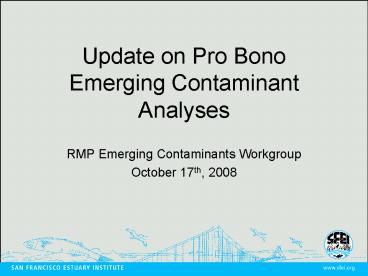Update on Pro Bono Emerging Contaminant Analyses - PowerPoint PPT Presentation
1 / 17
Title:
Update on Pro Bono Emerging Contaminant Analyses
Description:
... registered for use as fungicide, antibacterial, bactericide, & disinfectant. Hand soaps, toothpastes, detergents, deodorants, pesticides, imbedded in plastics ... – PowerPoint PPT presentation
Number of Views:39
Avg rating:3.0/5.0
Title: Update on Pro Bono Emerging Contaminant Analyses
1
Update on Pro Bono Emerging Contaminant Analyses
- RMP Emerging Contaminants Workgroup
- October 17th, 2008
2
Updates on EC Analyses
- Triclosan
- Chlorinated paraffins
- Potential Work for 2009, 2010
3
Triclosan
- Antimicrobial registered for use as fungicide,
antibacterial, bactericide, disinfectant - Hand soaps, toothpastes, detergents, deodorants,
pesticides, imbedded in plastics and clothing - Use regulated by FDA EPA
- log KOW 4.76
4
Why is Triclosan a Concern?
- Antimicrobial resistance
- Dioxin production from photolysis in fresh
seawater (Aranami and Readman, 2007) - Photolysis products include (Latch et al., 2005)
- 2,8-dichlorodibenzo-p-dioxin (2,8-DCDD)
- 2,4-dichlorophenol (2,4-DCP)
- Weakly estrogenic (Ishibashi, 2004)
5
RMP Sediment Analysis
- 10 surface sediment samples, 2008 ST
- Mark Cantwell, Rob Burgess EPA
NHEERL, Narragansett, RI - GC/MS, 13C labeled IS
6
Triclosan in SF Bay Sediments
- 2008 ST Monitoring
- MDL 5 ng/g dry
Draft data- do not cite or quote
7
Comparison to Other Locations
(RMP)
(Miller 2008)
(Miller 2008)
(Wilson 2008)
(Aquera 2003)
(Singer 2002)
8
Triclosan Toxicity
- No sediment toxicity studies
- Estimated SF Bay porewater concentration max 0.4
µg L-1 - Daphnia magna (Orvos et al., 2002)
- reproductive NOEC 40 µg L-1 LOEC 200 µg L-1
- Rainbow trout (Oncorhynchus mykiss) 71.3 µg L-1
(Orvos et al., 2002) - Decreased post-hatch survival, behaviorial
effects - Tadpoles (Rana pipens) (Fraker and Smith, 2004)
- Reduced activity 0.23 230.0 µg L-1
- Algae (Wilson et al., 2003)
- Reduce the biomass of algal communities 0.12 µg
L-1 - Change community structure and reduce genus
richness of algal communities at 0.012 µg L-1
- Microbial, algal, fish toxicity testing ongoing
(EPA NHEERL)
9
Additional Concerns
- Conversion to 2,7 2,8 dichlorodibenzodioxin?
- Methyl triclosan?
- Effluents and sanitary sewer overflows (SSOs)
10
Chlorinated Paraffins/Chlorinated n-Alkanes
- C10 to C30 technical mixtures
- 30 to 70 Cl- by mass
- Primary uses high temperature lubricants in
metal working machinery, flame retardants in
plastics - Minor uses additives in sealants, adhesives,
paints, rubber - Largest group of high molecular weight Cl
hydrocarbons in commercial use - Used since 1930s, declined after 1980s
- Bioaccumulative (log Kow 5.9-8.1)
- Ubiquitous
- Persistent, toxic, long-range transport
- Environmental fate, transport unknown
11
Chlorinated Paraffins/Chlorinated n-Alkanes
- Commercial formulations
- short (C10-C13), medium (C14-C17), long (C20-C30)
- Short-chain chlorinated paraffins
- Most extensive use
- Highest potential for env. release because of
open use - Highest toxicity
- Listings
- EPA Toxic Release Inventory
- Priority toxic substances (Canadian Env.
Protection Act) - Priority hazardous substance (EU)
- HPV chemicals in late 1990s
Concern for SF Bay?
12
Short-chain chlorinated paraffins
- Gregg Tomy (Canadian Dept of Fisheries and
Oceans) - White croaker from Oakland (1), South Bay (2) in
2006 - Cormorant eggs from 3 sites (1 comp/site) in 2006
- Harbor seal blubber (3 sites) in 2007
13
Chlorinated Paraffins in SF Bay Wildlife Compared
to Other Locations
lt0.9
5
SF Bay samples Surrogate standard quantifiable
in fish only (148, 65 and 119)
14
C11
C12
C10
White croaker
C13
Cormorant eggs
Harbor seal blubber
15
Other POPs in SF Bay Cormorant Eggs
16
Are Concentrations in SF Bay Wildlife a Concern?
- Limited toxicity information available, most
based on exposure to technical mixtures - Sub-lethal effects, most short-term exposures
- Chronic toxicity studies sparse
- Narcosis is mode of action
- Dietary uptake in juvenile rainbow trout (Cooley
et al 2001) - Narcosis effects, liver lesions at 220-5500 ng/g
body burden (SF Bay biota concentrations at least
1-2 orders of magnitude lower) - Low acute toxicity
17
Future/Potential Work
- Single-walled carbon nanotubes (L. Ferguson)
- Siloxanes? (M. Alaee, Environment Canada)
- Quaternary ammonium compounds?
- (400/sample, B. Brownawell, Stonybrook Univ.)































